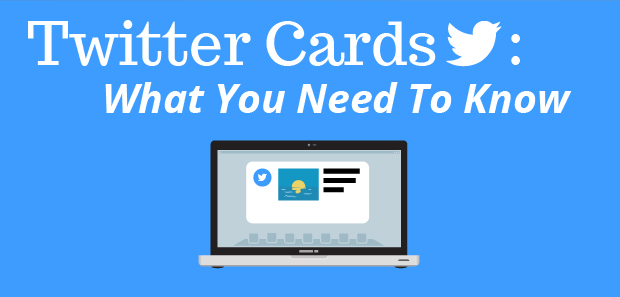
Twitter has come a long way since it was first launched, all those years ago, in 2006. Today, it is one of the most visited websites in the world and a social media force to be reckoned with, having a user-base of around half a billion people (with approximately 284 million of these users being considered ‘active’).
Aside from being incredibly popular with casual users, Twitter is a vital marketing tool for businesses, brands and organisations throughout the world, with everyone from The Chuckle Brothers to NASA broadcasting their messages to the world in the form of the network’s proprietary ‘tweets’.
Fairly recently, Twitter has made some pretty major changes to how its systems work, in order to bring a number of enhancements to its users. One of the biggest upgrades by far has come in the form of ‘Twitter Cards’…
What are Twitter Cards?
Once upon a time, the average tweet consisted of a short (140 characters long, to be precise) text message. Nowadays, you are just as likely to find videos, photos, galleries and a whole host of rich media presented in a number of distinct configurations, when you happen to browse through a user’s Twitter stream: This ability is made possible via Twitter’s ‘card’ system, which has a number of archetypal formats for presenting content.
What types of Twitter Cards are available?
Summary Card
This variety of card recognises when a URL is included in a Tweet and prepares a short preview of the content that is being linked to. Twitter’s system scans the linked website to create a suitable ‘preview’, which will typically appear below the 140 characters of the main tweet body.
Summary Card with Large Image
In much the same way that the Summary Card works, this variant crawls a linked website to provide users with an at-a-glance preview of the content that is being linked to, except this time, a large, full-width image features prominently, along with some text content, below the 140 character tweet section.
Photo Card
As its name suggests, the Photo Card allows a Twitter account holder to publish a large, prominent photo, along with the basic 140 character tweet text: For example, an image of some cupcakes could appear alongside the text: ‘Strawberry cupcakes, our latest creation’: This is fantastic for publishers who wish to promote a single product, service or event.
Gallery Card
When it is time to tweet about an assortment of images, the Gallery Card comes in handy: Whenever a user tweets a link to an online gallery of images, Twitter can summarise this by pulling through a selection of images and some text, which will all appear alongside the tweet text itself.
App Card
Let’s say a user wants to spread the word about a fantastic app via Twitter: Thanks to the App Card, this whole process is made super-simple: It provides room for an icon, name and description, as well as details like the app rating and price. Also, conveniently, it is possible to provide a download button, which will direct anyone who clicks on it to the appropriate iOS or Android store to get it on their device.
Player Card
When a tweet is used to link off to a media file, such as a YouTube video or Vine clip, Twitter can pull this content through via a Player Card, which allows the content to be viewed directly from the user’s Twitter feed.
Product Card
For businesses that use Twitter to promote their wares online, the Product Card is a fantastic tool: Along with an image and description, this type of card can pull through two additional titbits of information: For example, the price of the product and its shop category.
Is this a step too far for Twitter?
There is no doubt that Twitter has seriously upgraded its services with the addition of cards: Doing so means that it now pulls through rich media experiences to its audience, who can get their daily dose of product ads, video clips, photos and more without having to leave Twitter itself…
Many commentators, however, are now asking if this is too much of a deviation from the winning formula that made Twitter so popular in the first place: After all, the whole point of Twitter was to give users the ability to share to bite-sized, easy-to-digest nuggets of information: In this case, the choice to add enhancements seems to have prevailed over the strategy to refine an already simple, streamlined service. Only time will tell whether this move will pay off for San Francisco’s social media giant.
- Which mobile-friendly web design strategy is right for you? - August 28, 2015
- Errors to avoid in your social media marketing campaign - August 26, 2015
- Three things you must get right to run a successful e-com store - August 20, 2015
- Focus on the smallest details for a more mobile-friendly site - August 18, 2015
- Three reasons why physical retailers need an online presence - August 14, 2015
- Could your Scottish start-up benefit from a new digital grant? - August 13, 2015
- Does Google care if your website is responsive or not? - August 11, 2015
- Three powerful tips to boost your ecommerce conversions - June 15, 2015
- How Googles algorithm changes influence web design - June 7, 2015
- Stay on top of your Social Media Marketing with these 3 tips - June 2, 2015
You may also be interested in:
- Twitter Redesigned & Revamped – Details Here A big day for Twitter is here! Find out what's new in their microblogoverse... ...
- All Your Twitter Are Belonging to Congress The Library of Congress are starting a major undertaking by indexing Twitter for posterity, but how valuable are your tweets...
- Twitter Tackles Malicious Links Following on from twitter warning their users about 'phishing' attacks earlier this month, they are now implementing procedures to help...
- How Will Twitter Analytics Affect Your Business? The cock crows on a new dawn for Twitter...and potentially for your business! ...
- Will Twitter Advertising Take Flight? Will Twitter ever be able to cut it with the big boys of online advertising? ...





